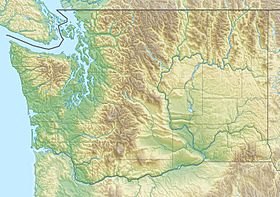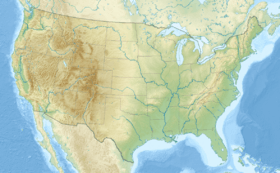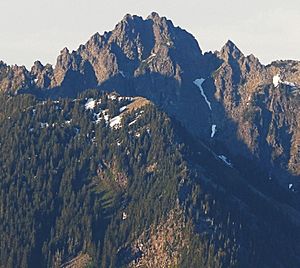Chair Peak (Washington) facts for kids
Quick facts for kids Chair Peak |
|
|---|---|
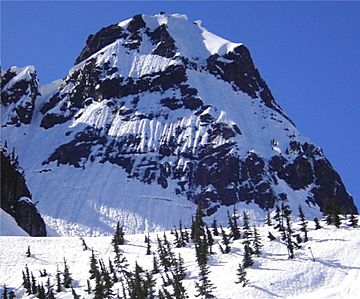
Chair Peak southeast aspect
|
|
| Highest point | |
| Elevation | 6,238 ft (1,901 m) |
| Prominence | 878 ft (268 m) |
| Isolation | 0.57 mi (0.92 km) |
| Parent peak | Kaleetan Peak (6,259 ft) |
| Geography | |
| Location | King County, Washington state, U.S. |
| Parent range | Cascade Range |
| Topo map | USGS Snoqualmie Pass |
| Climbing | |
| First ascent | 1913, Hec V. Abel and L.F. Curtis |
| Easiest route | Scrambling |
Chair Peak is a mountain in Washington state, standing at 6,238 ft (1,900 m) tall. It is located in King County, which is in the eastern part of the state.
This peak is part of the Cascade Range and is found within the Alpine Lakes Wilderness. Chair Peak is about three miles northwest of Snoqualmie Pass. The land around it is managed by the Mount Baker-Snoqualmie National Forest. Water flowing from the mountain eventually reaches the Snoqualmie River. Right next to Chair Peak, to its south, is Snow Lake, a very popular spot for hikers. The closest taller mountain is Kaleetan Peak, which is about 0.57 miles (0.92 km) to the west-northwest.
Weather at Chair Peak
Chair Peak is in a place with a marine west coast climate. This means it gets a lot of moisture from the Pacific Ocean. Most weather fronts, which are like big air masses, come from the Pacific Ocean. They then travel northeast towards the Cascade Mountains.
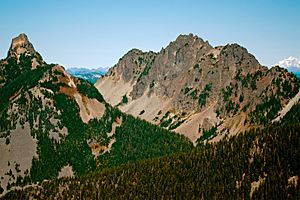
When these weather fronts hit the tall Cascade Mountains, they are forced to rise. As the air rises, it cools down and drops its moisture. This causes a lot of rain or snowfall on the western side of the Cascades. This process is called Orographic lift. Because of the ocean's influence, the snow here is often wet and heavy. This can lead to a high risk of avalanches.
During winter, the weather is usually cloudy. However, in the summer, high-pressure systems over the Pacific Ocean often bring clear skies. The best time to visit or climb Chair Peak is usually from July through September. This is when the weather is most favorable.
How Chair Peak Was Formed
The Alpine Lakes Wilderness area, where Chair Peak is located, has very rugged land. You can see sharp peaks, long ridges, deep valleys carved by glaciers, and tall granite walls. There are also more than 700 mountain lakes scattered around.
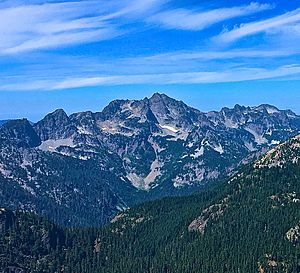
The amazing landscape we see today was created by huge geological events that happened millions of years ago. These events caused big changes in the land's height and led to different climates in various areas. These climate differences then created different types of plant life, defining the ecoregions here. The land in this area ranges from about 1,000 feet (300 m) in the lower parts to over 9,000 feet (2,700 m) on Mount Stuart.
The Cascade Range began forming millions of years ago, during a time called the late Eocene Epoch. This happened because the North American Plate (a huge piece of Earth's crust) was slowly moving over the Pacific Plate. This movement caused many periods of volcanic activity. Also, smaller pieces of Earth's crust, called terranes, joined together to form the North Cascades about 50 million years ago.
Later, during the Pleistocene period, which started over two million years ago, huge sheets of ice called glaciers moved across the land many times. As these glaciers advanced and then melted back, they scraped and shaped the landscape. They left behind piles of rock and debris. The last time glaciers melted away from the Alpine Lakes area was about 14,000 years ago. By 10,000 years ago, they had moved north of the Canada–US border. The "U"-shaped valleys you see in the rivers are a result of these recent glaciers.
The combination of the land being pushed up (uplift) and breaking apart along cracks (faulting), along with the action of glaciers, has created the tall peaks and deep valleys of the Alpine Lakes Wilderness area.


